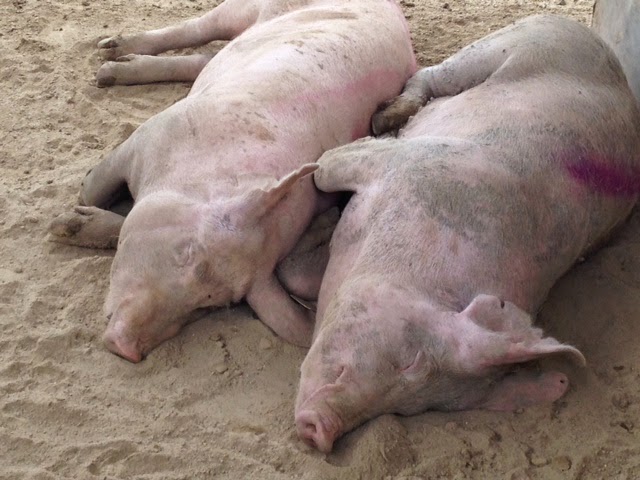But first, let me take a picture of two gilts (female hogs who haven't had piglets yet). The pink marker on the back of the right hog is a spray marker that we use when we separate pigs into groups. It washes off in the rain.
We talk a lot about what it is that we want to eat as people, and we begin to argue GMO versus Organic, and other similar arguments. We always talk about what we eat. Do we ever step back and look at what out animals eat?
I can't speak for most areas of the industry, without extensive research, on animal feeding practices. When it comes to pigs, I have spent enough time on a feed grinder making dinner for the pigs to discuss this.
Okay, it looks yellow, its dry, and it smells good. What gives - what's in it?
Due to the nutrient requirements of pigs, there are a lot of things in the feed.
For an 8000lb load of feed you can anticipate that the largest portion of you load will be comprised of corn -
1. Ground up #2 Yellow corn. It can be organic, GMO, pigs don't care and due to a study since the first GMO corn was put on the market, there is no difference. Pigs are simply thrilled that it's time to eat again!
2. Your next largest component is Soybean Meal. This is used to be the high protein component of the ration.
3. If you feed Dried Distillers Grains, this will likely be next in order of quantity in finishing or "fat hog" feed. Distillers grains are that is left of the corn kernels after it is refined for ethanol, the oil has been extracted, and sugars removed. In breeding stock you will typically not find distillers grains. It is a substitute for around 10% max of the corn. Things have recently changed as mills have learned ways to extract even more of the valuable parts form corn before they sell dried distillers grains (DDGs) and thus it is a less useful substitute today than it was in the past
4. In a smaller volume, there is typically some sort of base mix. Base mix is usually a mixture of things that are essentials to a healthy diet for happy pigs.
5. And in small amounts (very small), since pigs do not produce these essentials naturally, there will be Methionine, Threonine, and Lysine (amino acids). If we are nearing the end of the "finishing" stage, some producers use Paylean to help finish the 'growing out' stage, . Other things vary based on conditions, such as whether you raise hogs inside or outside, and other similar conditions.
We feed sows one scoop of feed at a time in group pens. The feed is stored in this bin 8000 lbs per load.
This is what it looks like when we go a while without re-stocking on our amino acids, and get a lot at once to have on-hand.
This is breeding hog feed, soft, fluffy, and smells pretty good. It's ground very fine and scooped to the sows and boars.
Please reach out to me on other forms of social media!
Facebook Page, Twitter, Pinterest, or Instagram
Linking up with Holly and the other 30 Days Bloggers Here!
Facebook Page, Twitter, Pinterest, or Instagram
Linking up with Holly and the other 30 Days Bloggers Here!




No comments:
Post a Comment